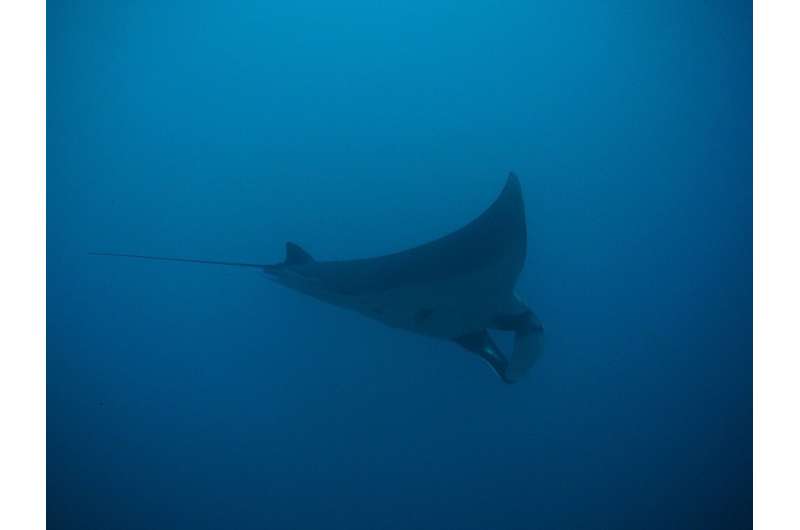Tourists and fishers key to future of rare manta nursery

Two manta ray hotspots in waters near Bali identified in new research as vital habitats for the threatened species, could be at risk from unregulated tourism and small scale/ artisanal fishing.
Both areas, in waters off the island of Nusa Penida, are increasingly frequented by tourism operators potentially putting the manta populations under pressure.
The new study, led by Murdoch University and Marine Megafauna Foundation Ph.D. student Elitza Germanov, found one hotspot – known as Manta Bay—was frequented by juvenile male mantas looking for food, suggesting the area is a nursery for the threatened species.
The researchers also found mature males and females congregating in large numbers at Manta Point, 12 km from Manta Bay, where the large creatures were observed visiting cleaning stations and engaging in courtship displays during the mating season (which peaks in May).
Ms Germanov said that while mantas are protected in Indonesia, there are few regulations in place to manage the growing tourism industry. The number of boats allowed to enter manta ray habitats is not limited and codes of conduct for manta ray interactions are voluntary.
"Large diving groups and boat engine noise can cause chronic stress to these vulnerable animals," Ms Germanov said.
To minimise the impact from tourism, the researchers have proposed limiting the number of tourism boats allowed at one time and making codes of conduct for diving and snorkeling with mantas rays mandatory.
A co-author on the research, Dr. I. Gede Hedrawan of Udayana University in Bali, said the new findings could inform conservation efforts in the area.
"Since being declared a Marine Protected Area (MPA) in 2014, Nusa Penida has become an attractive area for tourism and international scientists," Dr. Hedrawan said. "This new research will prove useful for MPA managers, informing future reviews and allowing them to assess the appropriate capacity for manta ray watching in this diving hotspot."
Injuries from fishing gear
The researchers also found that small-scale, traditional fishing poses a threat to the manta rays. During the study, 14 per cent of manta rays were seen either trailing hooks and lines or had injuries and even amputations from fishing gear cutting through their skin and cartilage skeleton.
While all fishing activities are prohibited at Manta Bay and Manta Point, the researchers suggest the whole west coast of Nusa Penida could be closed off to fishing as a precaution and fishing bans be better enforced.
Ms Germanov said it was vital to learn more about the manta rays in Indonesia, so more could be done to protect them.
"Where manta rays are born and grow up still baffles us," she said. "Our research in Indonesia suggests there might be a reef manta nursery in the Nusa Penida area, which is important for us to know because they provide a safe space for young, vulnerable mantas to grow and develop away from the reach of predators."
The data for this study were obtained from citizen scientists and trained observers submitting ID photos to the global manta ray database MantaMatcher over the course of six years, from 2012. A total of 624 reef manta rays were identified from 5,913 sightings based on their unique ventral coloration patterns and sex and maturity indicators.
The study, titled "Contrasting habitat use and population dynamics of reef manta rays within the Nusa Penida Marine Protected Area, Indonesia," has been published in the journal Frontiers in Marine Science.
More information: Elitza S. Germanov et al. Contrasting Habitat Use and Population Dynamics of Reef Manta Rays Within the Nusa Penida Marine Protected Area, Indonesia, Frontiers in Marine Science (2019). DOI: 10.3389/fmars.2019.00215
Provided by Murdoch University
















